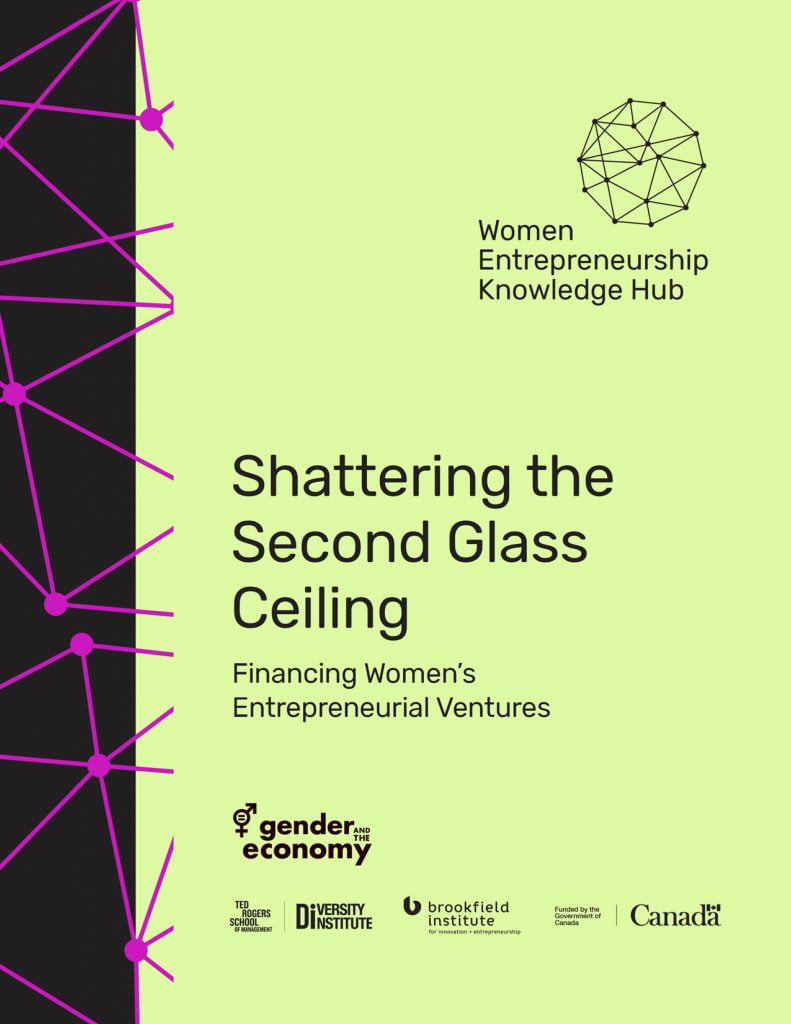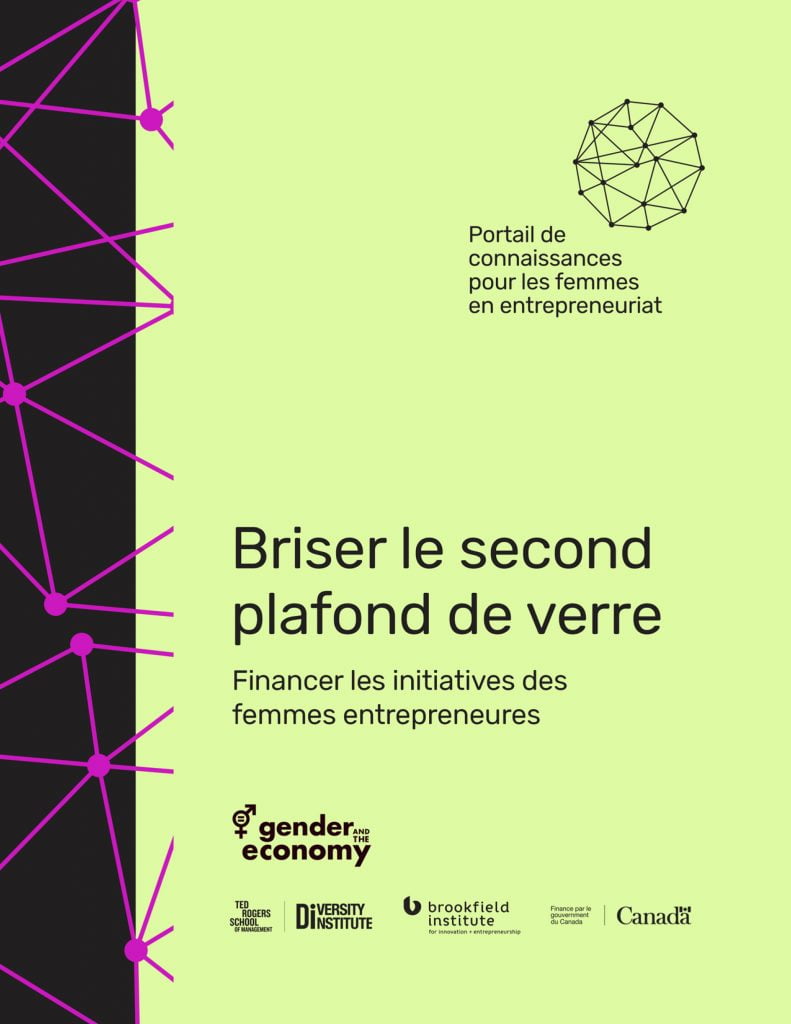Download this research brief (in English/en Français).
Overview
Securing funding is one of the first obstacles every entrepreneur must overcome. But, for women entrepreneurs, accessing financial capital is even more challenging than it is for men. For example, in 2018 nearly 98% of all venture capital funding in the United States went to start-ups owned and operated by men.[1] That means only 2.2% went to women entrepreneurs. Scholars have described this phenomenon as the “second glass ceiling.”[2] This research brief provides an overview of existing academic literature about the barriers to funding and financing for women entrepreneurs, identifying current gaps in research, providing recommendations for future work, and practical implications for researchers, funders and entrepreneurs.
Today, only 16% of businesses in Canada are owned or led by women.[3] Why does this matter? Not only do women entrepreneurs represent an important source of economic growth and provide valuable and diverse perspectives, committing to supporting women’s entrepreneurship is one step toward a more just and equitable world.
What does it mean to be an entrepreneur?
Historically, an entrepreneur was defined as someone who managed theatrical productions, borrowing from the French entrepreneur: “one who undertakes or manages.”[4] In the 15th century, the word began to be used by English speakers to describe business managers in general. During industrialization, entrepreneurship became inextricably linked to capitalism, machines, and men. This association continues resulting in the conflation of entrepreneurship with innovation and masculinity, particularly in the technology sector.
One of the challenges in understanding what the research says about women entrepreneurs is that the definition of entrepreneur used today is often very narrow. For example, self-employed women may not be considered entrepreneurs. As a result, this research overview focuses primarily on studies about founders (that is, women who start companies), but also includes work about women who lead small and medium-sized enterprises (SMEs).
Research about women and entrepreneurship is relatively young.
Although scholars have studied entrepreneurship since the 1930s, the first research article about women and entrepreneurship was not published until the mid-1970s.[5] The literature reviewed below comes from a variety of peer-reviewed academic sources. We’ve sought to include seminal studies as well as contradictory findings and more recent research. When discussing emerging trends (e.g., “sidepreneurship”), we also cite relevant popular sources (e.g., Fortune, Forbes). It’s important to note, however, that this is a nascent area of study, deserving more time and attention from researchers in diverse disciplines.[6] Finally, it’s also telling that many of the top tier journals in fields like finance, management, and organizational studies have published relatively few studies about women entrepreneurs and funding.[7] Note that there is even more limited research on the experiences of transgender and gender non-conforming entrepreneurs and so we can only offer some suggestions for future research in this domain.[8]
What existing research tells us about women entrepreneurs and funding
Research says women entrepreneurs are less likely to seek certain kinds of funding, but a closer look proves it’s more complicated than “women don’t ask.”
Research suggests women are less likely to seek funding provided by formal, external sources (e.g., angel investors, venture capitalists, public lenders).[9],[10] For example, a 2008 study found that significantly fewer women-led firms—less than 9%—were likely to seek angel investment (meaning, investment from a high-net worth individual who uses their own capital).[11]
Why do women seemingly exclude themselves from certain kinds of funding? A growing body of work suggests that, while self-efficacy, imperfect information, and internalized sexism—sometimes contributing to what researchers call the “discouraged borrower” phenomenon[12],[13] —may play a role, so too does the presence (or absence) of start-up helpers (i.e., supporters who are not financially involved)[14] and women’s perceptions of how effective asking for funding may (or may not) be.[15]
When it comes to venture capital (meaning, private equity provided by a group of investors), women may not seek venture capital (VC) financial support because, historically, they’ve been less likely to receive it and because VCs, in general, exhibit little gender diversity.[16] In other words, women may not seek funding from formal, external sources for a variety of reasons, many of which overlap and are reinforced by their own experiences and the experiences of other women.
This brings us to the supply vs. demand debate in the literature.[17] While some researchers argue women don’t seek funding (there’s no supply of women entrepreneurs), others argue investors are unwilling to invest in women entrepreneurs (there is no demand to invest in women’s entrepreneurship). This debate speaks to a dynamic sociological and economic phenomenon that is often difficult to tease apart, but recent research suggests that both factors are at play.[18] However, what we do know from the research is that, historically, the deck has been stacked against women seeking funding, particularly when it comes to biases held by gatekeepers.
Investors evidence biases against women entrepreneurs.
Investors evidence biases that impact their decisions to fund (or not fund) women. For example, a series of studies have found that investors are less likely to invest in women-led start-ups even when factors like start-up quality, sector focus, and risk were similar.[19],[20],[21] Furthermore, some research suggests investors ask different things of women entrepreneurs than of their male counterparts. According to one study, investors involved in TechCrunch Disrupt New York City from 2010 to 2016 consistently asked men how they would succeed and women how they would avoid failure.[22] And it isn’t only that investors ask men and women different kinds of questions during pitches; they also use different kinds of language to describe men and women entrepreneurs. For example, Malmstrom and colleagues (2017) recorded the conversations governmental VCs in Sweden had about both men and women entrepreneurs and found that, overwhelmingly, VCs described women in a way that undermined their credibility, knowledge, trustworthiness, and experience.[23]
It appears that these effects may differ by sector. Evidence from France shows that women entrepreneurs are less likely to use external equity in male-dominated sectors but more likely to use external equity in female-dominated sectors.[24] Unfortunately, most sectors are male-dominated, which leaves women with access to financing in a much smaller part of the economy. Because the bar is higher for women in male-dominated sectors, this same study showed that—conditional on receiving funding—women-led businesses outperform their male counterparts in these male-dominated sectors.
Bank lenders also evidence biases against women-led businesses.
Investors aren’t the only stakeholders who enact biases against women entrepreneurs. Studies find loan officers also evidence gender biases that negatively impact women seeking start-up capital. However, this bias plays out in ways that are more complicated than the gender of the individual bank lender. That is, researchers have found that both men and women loan officers perceive women entrepreneurs as more risk-averse and less autonomous than men.[25] Furthermore, the processes by which loan officers make decisions—including the protocols and practices they use—can reinforce gender norms and stereotypes, further excluding women.[26],[27]
Women entrepreneurs are more likely to rely on informal networks for funding.
Given the findings noted above, it’s perhaps unsurprising women entrepreneurs often seek financial support from informal networks.[28] Overall, women are more likely to rely on credit cards, personal savings, and/or “love” money (meaning, capital provided by family and friends) than men.[29] Other research suggests that women—particularly those in traditionally male-dominated sectors such as technology— may benefit more from crowdfunding (e.g., through Kickstarter) than men do because of activist women investors on those platforms.[30],[31]
Race and class inequalities shape women entrepreneur’s experiences.
In the past several years, businesses founded, owned, and operated by women of color, newcomer and immigrant women, and women with low socioeconomic status (SES) have grown significantly. However, too often research about women entrepreneurs presents a homogenized view of “female entrepreneurs” as though every woman’s experience is the same. We know this isn’t true.[32] Intersectionality—the interconnected nature of social categorizations such as race, class, and gender and how they create overlapping and interdependent systems of discrimination—means that race and class inequalities radically shape women entrepreneurs’ experiences of seeking and securing funding. For example, a study of women entrepreneurs in the Southern United States found that Black women starting their own businesses are more likely than their white counterparts to depend on a “multiplicity of resources,” combining public and private sources of capital and drawing on family members to provide free labor.[33] Similarly, a study of women entrepreneurs in Sweden found immigrant women were more likely to rely on loans from family members than their native-born counterparts.[34]
To date, research about ethnic entrepreneurship and intersectionality has been undertaken largely by scholars outside of disciplines traditionally associated with business (e.g., anthropology, sociology).
Women entrepreneurs in developing countries have different experiences.
Recent research about how context impacts entrepreneurship has resulted in a wave of emerging work about women entrepreneurs in developing countries where they have even less access to capital.[35] Microfinancing (meaning, small collateral-free loans generally provided to unemployed or low SES individuals) has been championed as a way to help women establish their own businesses thereby facilitating their empowerment and subsequently reducing poverty. In some cases, microfinancing women entrepreneurs seems to have proven successful.[36],[37] In others, microfinancing has failed largely due to unacknowledged cultural realities. For example, a study of microfinance in Ethiopia revealed that, due to gender dynamics in families (e.g., decision making, the division of household labor), women who receive microloans often don’t have access to the funds and become even more overworked.[38]
Funding is only one of the challenges women face in the entrepreneurship ecosystem.
Women continue to be at a disadvantage in the larger entrepreneurship ecosystem.[39] Funding and financing, though significant, is only one of the challenges women face. Women entrepreneurs also face a lack of role models, gendered cultural expectations regarding what it means to be an entrepreneur and work-life balance, and, at times, blatant sexism and harassment.[40],[41] Women of color, newcomer and immigrant women, and women with low SES face additional hurdles including, but not limited to, racism, classism, language barriers, and the long-term effects of discrimination. Many of these challenges compound women’s access to financial capital as they start and as they grow their businesses.[42]
What we still don’t know about women entrepreneurs and funding
As noted above, research about women and entrepreneurship is relatively new, and much of it has leveraged what’s called a deficit model—asking why women entrepreneurs can’t be more like men.[43] But these limitations provide ample opportunities for future work. As Leitch and colleagues write in their introduction to a 2018 recent special issue of Venture Capital devoted to research about women entrepreneurs, despite a decade of research, “we do not seem to have progressed far […] in either theoretical development or in understanding the challenges which women continue to face in accessing entrepreneurial finance.”[44] For example, how does the underrepresentation of women in the financial sector impact women entrepreneurs’ access to funding? What alternatives to microfinance exist for women starting businesses in non-Western settings? How do national and international financial crises impact women entrepreneurs? How are women financing the increasing “sidepreneurship” endeavors they’re pursuing?[45] What kinds of structural interventions best address the persistent gender gap in entrepreneurial funding? And, perhaps most provocative, if women entrepreneurs have the same access to financial capital as their male peers, what will happen?
Addressing barriers to funding and financing for women entrepreneurs
Given the challenges of funding and financing for women entrepreneurs, what’s the best way to overcome the unique hurdles women face? Although many of the challenges women entrepreneurs face are the by-products of institutionalized sexism—a problem that is nearly impossible to solve due to its social complexities and interdependencies—research suggests the following practices are reasonable first steps:
- Ask women entrepreneurs what they need most. As noted above, there is still much we don’t know about women entrepreneurs in general and about women entrepreneurs and funding more specifically. The bulk of research in the past few decades has focused primarily on traditional models of entrepreneurship, reifying dichotomies and, at times, reinforcing stereotypes. To move forward, we need to ask women entrepreneurs what they need most and understand how they define what it means to be an entrepreneur.
- Challenge stereotypes. Entrepreneurship is often equated with heterosexual masculinity, and this conflation can perpetuate insidious stereotypes.[46] Instead of positioning women as in a deficit relative to men, we can imagine women’s entrepreneurship on its own terms, offering alternative models for business creation and economic growth.[47] One way we can challenge these stereotypes is to build awareness of women entrepreneurs’ successes and promote them as role models. Here, representation matters. For example, we can consider illustrating content about entrepreneurship with images of women or conducting case studies about women-owned firms—not as an exception but as a rule.
- Pay attention to context. Because the research shows that access to finance will differ based on the type of finance, the sector, and the country context, research and practical recommendations will need to take into account these differing circumstances.
- Create networks. Decades of research find that entrepreneurs of all genders benefit from strong networks.[48] By creating networks for women, non-binary, and transgender entrepreneurs, we can support people who may not identify with the ways in which entrepreneurship has been historically and conventionally construed. These networks, however, should be gender inclusive and supported by allies as women-only networks have proven to be problematic given women already have limited access to financial capital.[49]
- Redefine innovation. Current definitions of “innovation” are narrow, favoring technological advancements and, subsequently, prioritizing the technology sector where women are already underrepresented. As a result, investors often overlook the kinds of radical innovations women entrepreneurs introduce in the marketplace, including in the services and retail sectors.[50]
- Support inclusive policies and practices. Women and other historically marginalized entrepreneurs benefit from policies and practices that recognize and seek to redress institutionalized bias and discrimination in material and instrumental ways. Initiatives like the Government of Canada’s first ever Women Entrepreneurship Strategy—which has funded more than 50 projects—can effect substantial change by supporting women entrepreneurs with immediate access to capital, expertise, and networks.
__________________________
Research overview prepared by:
Dr. Amanda Menking, under the supervision of Professor Sarah Kaplan, Director, Institute for Gender and the Economy at the University of Toronto’s Rotman School of Management.
The preparation of this research overview was supported by the Government of Canada’s Women Entrepreneurship Knowledge Hub (WEKH).
Cite as:
Menking, Amanda (2020), “Shattering the second glass ceiling: Financing women’s entrepreneurial ventures,” Institute for Gender and the Economy, https://www.gendereconomy.org/shattering-the-second-glass-ceiling/.
References
[1] Hinchliffe, E. (2019, January 28). Funding for female founders stalled at 2.2% of VC dollars in 2018. Fortune. Retrieved https://fortune.com/2019/01/28/funding-female-founders-2018/
[2] Bosse, D.A., & Taylor, P.L. (2012). The second glass ceiling impedes women entrepreneurs. The Journal of Applied Management and Entrepreneurship, 17(1), 52-68.
[3] Women Entrepreneurship Strategy. (n.d.). Government of Canada. Retrieved from https://www.ic.gc.ca/eic/site/107.nsf/eng/home
[4] Entrepreneur. (n.d.). Online etymology dictionary. Retrieved from https://www.etymonline.com/word/entrepreneur#etymonline_v_8748
[5] Jennings, J. E., & Brush, C. G. (2013). Research on women entrepreneurs: Challenges to (and from) the broader entrepreneurship literature? The Academy of Management Annals, 7(1), 663-715.
[6] Ahl, H. (2006). Why research on women entrepreneurs needs new directions. Entrepreneurship Theory and Practice, 30(5), 595-621.
[7] Drawing on subject terms and author keywords from seminal studies and meta-reviews (e.g., Jennings & Brush, 2013), we used Business Search Premier to search top tier journals (e.g., Academy of Management Journal, Administrative Science Quarterly, Strategic Management Journal, Organization Science, Journal of Finance, Journal of Financial Economics, Journal of Management) without date delimiters using the following key phrases and variations thereof: women, female, gender, female entrepreneurs, female entrepreneurship, women entrepreneurs, women entrepreneurship, gender + entrepreneurs, gender + entrepreneurship, gender gap + funding, women entrepreneurs + capital, women entrepreneurs + funding, women entrepreneurs + financing, women-owned business enterprises, and businesswomen. In total, across these publications and search terms, we found only 10 articles relevant to the topic of women entrepreneurs and funding.
[8] We located one study based on evidence from Viet Nam (Pauline Oosterhoff & Tu-Anh Hoang (2018) Transgender employment and entrepreneurialism in Vietnam, Gender & Development, 26:1, 33-51) and a few conference papers such as Ruebottom, Trish & Madeline Toubiana (2017), Biographical Opportunities: How Entrepreneurship Creates Pride in Alterity in Stigmatized Fields, Academy of Management Proceedings, https://doi.org/10.5465/AMBPP.2017.12168abstract.
[9] Coleman, S. (2000). Access to capital and terms of credit: A comparison of men-and women-owned small businesses. Journal of Small Business Management, 38(3), 37.
[10] Coleman, S., & Robb, A. (2012). Capital structure theory and new technology firms: Is there a match? Management Research Review, 35(2), 106-120.
[11] Becker-Blease, J.R., & Sohl, J. (2008). Confidence and angel investors: Does gender matter? Frontiers of Entrepreneurship Research.
[12] Kon, Y., & Storey, D.J. (2003). A theory of discouraged borrowers. Small Business Economics 21(1), 37-49.
[13] Mijid, N. (2014). Why are female small business owners in the United States less likely to apply for bank loans than their male counterparts? Journal of Small Business & Entrepreneurship, 27(2), 229-249.
[14] Kwapisz, A., & Hechavarría, D.M. (2018). Women don’t ask: An investigation of start-up financing and gender. Venture Capital, 20(2), 159-190.
[15] Naegels, V., Mori, N., & D’Espallier, B. (2018). An institutional view on access to finance by Tanzanian women-owned enterprises. Venture Capital, 20(2), 191-210.
[16] Brush, C., Greene, P., Balachandra, L., & Davis, A. (2018). The gender gap in venture capital-progress, problems, and perspectives. Venture Capital, 20(2), 115-136.
[17] Fernandez-Mateo, Isabel & Sarah Kaplan (2018), Gender and Organization Science, Organization Science, 29(6): 1229–1236.
[18] Guzman J, Kacperczyk A (Olenka) (2019) Gender gap in entrepreneurship. Research Policy 48(7):1666–1680.
[19] Ewens, M., & Townsend, R. R. (2019). Are early stage investors biased against women? Journal of Financial Economics.
[20] Brooks AW, Huang L, Kearney SW, Murray FE (2014) Investors prefer entrepreneurial ventures pitched by attractive men. PNAS 111(12):4427–4431.
[21] Bigelow, L., Lundmark, L., McLean Parks, J., & Wuebker, R. (2014). Skirting the Issues: Experimental Evidence of Gender Bias in IPO Prospectus Evaluations. Journal of Management, 40(6), 1732–1759.
[22] Kanze, D., Huang, L., Conley, M. A., & Higgins, E. T. (2018). We ask men to win and women not to lose: Closing the gender gap in startup funding. Academy of Management Journal, 61(2), 586-614.
[23] Malmström, M., Johansson, J., & Wincent, J. (2017). Gender stereotypes and venture support decisions: How governmental venture capitalists socially construct entrepreneurs’ potential. Entrepreneurship Theory and Practice, 41(5), 833-860.
[24] Hebert, Camille, The Minority Effect: Gender Stereotypes and Entrepreneur Financing (December 1, 2019). Available at SSRN: https://ssrn.com/abstract=3318245 or http://dx.doi.org/10.2139/ssrn.3318245
[25] Buttner, E. H., & Rosen, B. (1988). Bank loan officers’ perceptions of the characteristics of men, women, and successful entrepreneurs. Journal of Business Venturing, 3(3), 249-258.
[26] Carter, S., Shaw, E., Lam, W., & Wilson, F. (2007). Gender, entrepreneurship, and bank lending: The criteria and processes used by bank loan officers in assessing applications. Entrepreneurship Theory and Practice, 31(3), 427-444.
[27] Eddleston, K. A., Ladge, J. J., Mitteness, C., & Balachandra, L. (2016). Do you see what I see? Signaling effects of gender and firm characteristics on financing entrepreneurial ventures. Entrepreneurship Theory and Practice, 40(3), 489-514.
[28] Nancy Carter, Candida Brush, Patricia Greene, Elizabeth Gatewood & Myra Hart (2003) Women entrepreneurs who break through to equity financing: The influence of human, social and financial capital, Venture Capital, 5:1, 1-28
[29] Manolova, T. S., Manev, I. M., Carter, N. M., & Gyoshev, B. S. (2006). Breaking the family and friends’ circle: Predictors of external financing usage among men and women entrepreneurs in a transitional economy. Venture Capital, 8(02), 109-132.
[30] Marom, D., Robb, A., & Sade, O. (2016). Gender dynamics in crowdfunding (Kickstarter): Evidence on entrepreneurs, investors, deals and taste-based discrimination. Investors, Deals and Taste-Based Discrimination.
[31] Greenberg, J., & Mollick, E. (2017). Activist choice homophily and the crowdfunding of female founders. Administrative Science Quarterly, 62(2), 341-374.
[32] Neumeyer, X., Santos, S. C., Caetano, A., & Kalbfleisch, P. (2019). Entrepreneurship ecosystems and women entrepreneurs: A social capital and network approach. Small Business Economics, 53(2), 475-489.
[33] Inman, K. (2000). Women’s Resources in Business Start‐Up. A Study of Black and White Women Entrepreneurs. Garland Publishing.
[34] Abbasian, S., & Yazdanfar, D. (2013). Exploring the financing gap between native born women-and immigrant women-owned firms at the start-up stage: Empirical evidence from Swedish data. International Journal of Gender and Entrepreneurship, 5(2), 157-173.
[35] Poggesi, S., Mari, M., & De Vita, L. (2016). What’s new in female entrepreneurship research? Answers from the literature. International Entrepreneurship and Management Journal, 12(3), 735-764.
[36] Estapé-Dubreuil, G., & Torreguitart-Mirada, C. (2010). Microfinance and gender considerations in developed countries: The case of Catalonia. Management Research Review, 33(12), 1140-1157.
[37] Hussain, J., Mahmood, S., & Scott, J. (2019). Gender, Microcredit and Poverty Alleviation in a Developing Country: The Case of Women Entrepreneurs in Pakistan. Journal of International Development, 31(3), 247-270.
[38] Geleta, E. B. (2016). Microfinance and women’s empowerment: an ethnographic inquiry. Development in Practice, 26(1), 91-101.
[39] Aidis, R., & Weeks, J. (2016). Mapping the gendered ecosystem: The evolution of measurement tools for comparative high-impact female entrepreneur development. International Journal of Gender and Entrepreneurship, 8(4), 330-352.
[40] Thébaud, S. (2015). Business as Plan B. Administrative Science Quarterly, 60(4), 671–711.
[41] Jones, K., & Clifton, J. (2018). Rendering sexism invisible in workplace narratives. A narrative analysis of female entrepreneurs’ stories of not being talked to by men. Gender, Work & Organization, 25(5), 557–574.
[42] Yang, T., & del Carmen Triana, M. (2019). Set up to fail: Explaining when women-led businesses are more likely to fail. Journal of Management, 45(3), 926-954.
[43] Marlow, S., & Swail, J. (2014). Gender, risk and finance: Why can’t a woman be more like a man? Entrepreneurship & Regional Development, 26(1-2), 80-96.
[44] Leitch, C., Welter, F., & Henry, C. (2018). Women entrepreneurs’ financing revisited: Taking stock and looking forward: New perspectives on women entrepreneurs and finance. Venture Capital, 20(2), 103-114.
[45] Hannon, K. (2019, October 24). Sidepreneurship: The booming trend for women. Forbes. Retrieved from https://www.forbes.com/sites/nextavenue/2019/10/24/sidepreneurship-the-booming-trend-for-women/#597e5a943fc1
[46] Bruni, A., Gherardi, S., & Poggio, B. (2004). Doing gender, doing entrepreneurship: An ethnographic account of intertwined practices. Gender, Work & Organization, 11(4), 406-429.
[47] Ahl, H., & Marlow, S. (2012). Exploring the dynamics of gender, feminism and entrepreneurship: advancing debate to escape a dead end? Organization, 19(5), 543–562.
[48] Malecki, E. J. (2019). Entrepreneurs, Networks, and Economic Development Revisited, Reflections and Extensions on Key Papers of the First Twenty-Five Years of Advances. Emerald Publishing Limited. Publisher Emerald Publishing Limited Copyright, 117-126.
[49] McAdam, M., Harrison, R. T., & Leitch, C. M. (2019). Stories from the field: Women’s networking as gender capital in entrepreneurial ecosystems. Small Business Economics, 53(2), 459-474.
[50] Beckton, C., McDonald. J., & Marquis-Bissonnette. (2018). Everywhere, every day innovating: Women entrepreneurs and innovation. Report. Retrieved from https://carleton.ca/creww/?p=1393
Research summary prepared by
Amanda Menking
Published
November, 2020









